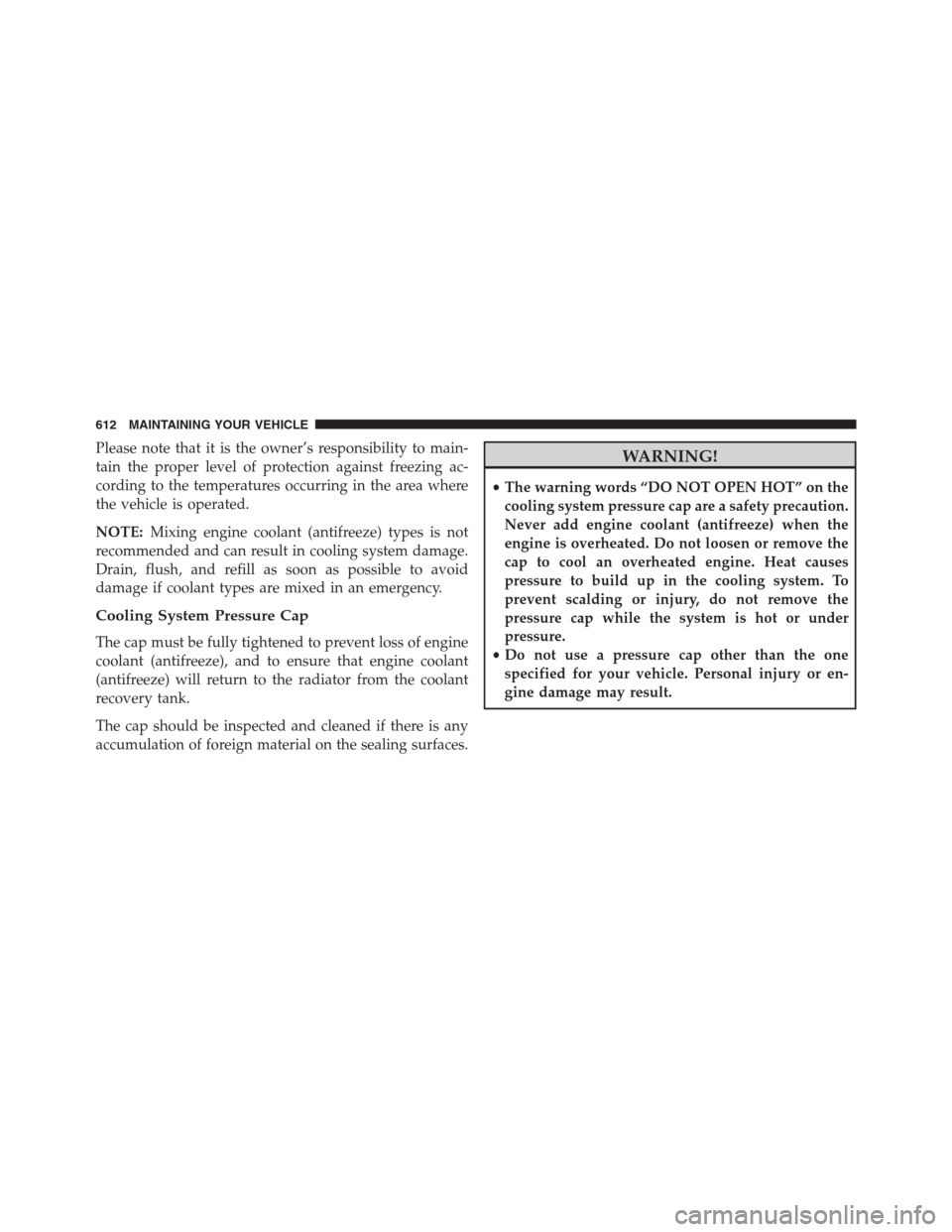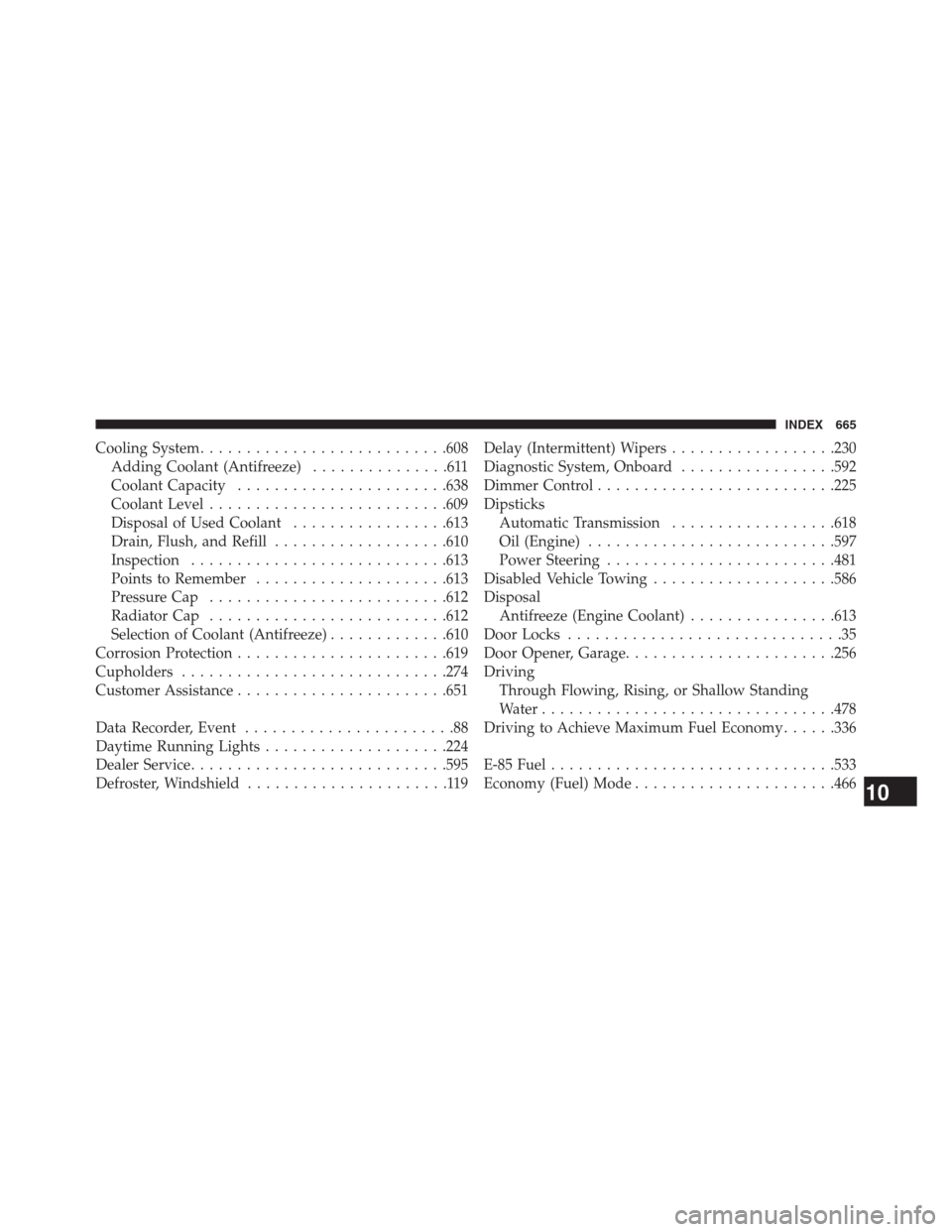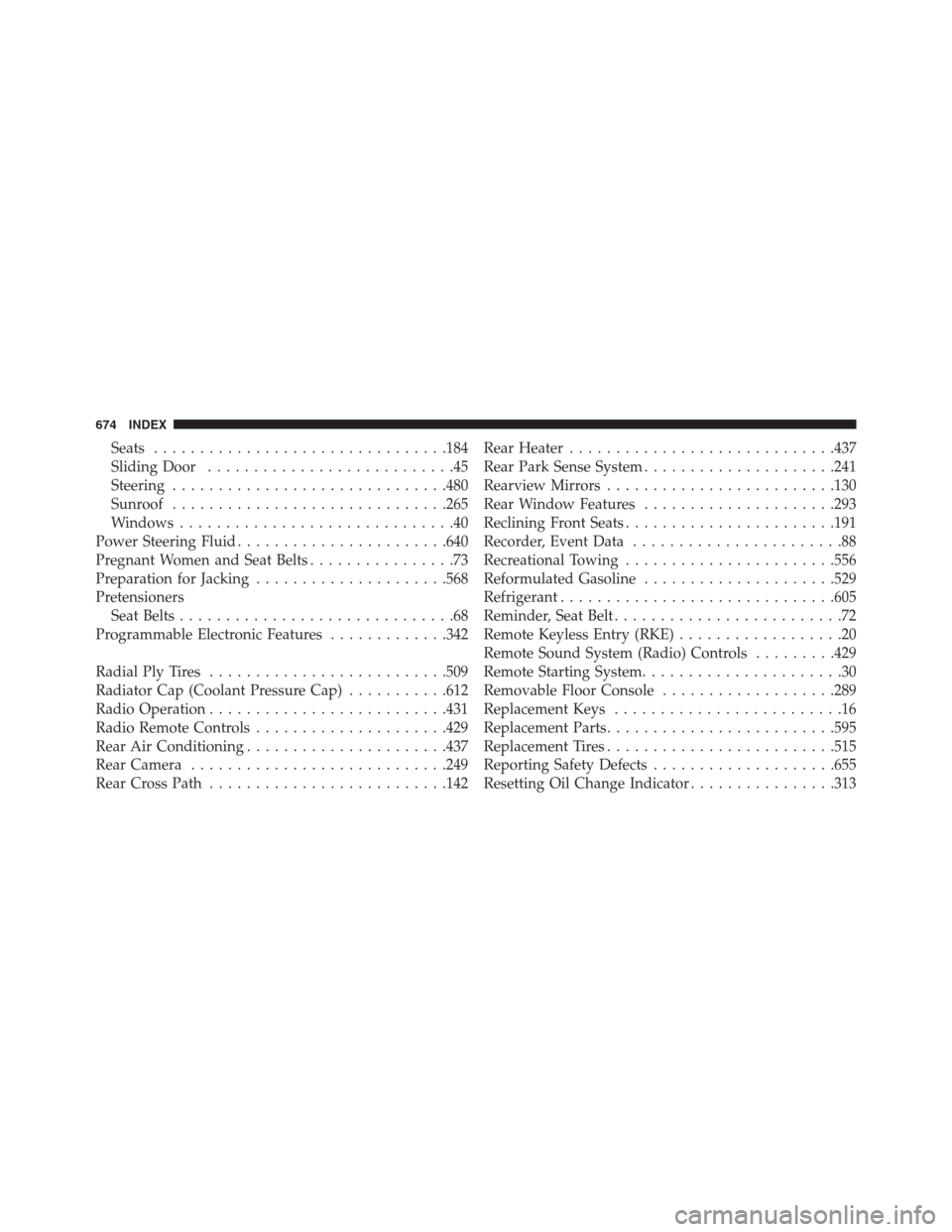2013 DODGE GRAND CARAVAN radiator cap
[x] Cancel search: radiator capPage 563 of 683

CAUTION!
Driving with a hot cooling system could damage
your vehicle. If temperature gauge reads “H”, pull
over and stop the vehicle. Idle the vehicle with the air
conditioner turned off until the pointer drops back
into the normal range. If the pointer remains on the
“H”, turn the engine off immediately, and call for
service.
WARNING!
You or others can be badly burned by hot engine
coolant (antifreeze) or steam from your radiator. If
you see or hear steam coming from under the hood,
do not open the hood until the radiator has had time
to cool. Never try to open a cooling system pressure
cap when the radiator or coolant bottle is hot.
JACKING AND TIRE CHANGING
WARNING!
•Do not attempt to change a tire on the side of the
vehicle close to moving traffic. Pull far enough off
the road to avoid the danger of being hit when
operating the jack or changing the wheel.
•Being under a jacked-up vehicle is dangerous. The
vehicle could slip off the jack and fall on you. You
could be crushed. Never put any part of your body
under a vehicle that is on a jack. If you need to get
under a raised vehicle, take it to a service center
where it can be raised on a lift.
•Never start or run the engine while the vehicle is
on a jack.
(Continued)
6
WHAT TO DO IN EMERGENCIES 561
Page 611 of 683

WARNING!(Continued)
•You or others can be badly burned by hot engine
coolant (antifreeze) or steam from your radiator. If
you see or hear steam coming from under the hood,
do not open the hood until the radiator has had
time to cool. Never try to open a cooling system
pressure cap when the radiator is hot.
Coolant Checks
Check the engine coolant (antifreeze) protection every
12 months (before the onset of freezing weather, where
applicable). If the engine coolant (antifreeze) is dirty, the
system should be drained, flushed, and refilled with
fresh OAT coolant (conforming to MS-12106) only by an
authorized dealer. Check the front of the A/C condenserfor any accumulation of bugs, leaves, etc. If dirty, clean by
gently spraying water from a garden hose vertically
down the face of the condenser.
Check the coolant recovery bottle tubing for brittle rubber,
cracking , tears, cuts and tightness of the connection at the
bottle and radiator. Inspect the entire system for leaks.
With the engine at normal operating temperature (but
not running), check the cooling system pressure cap for
proper vacuum sealing by draining a small amount of
engine coolant (antifreeze) from the radiator drain cock.
If the cap is sealing properly, the engine coolant (anti-
freeze) will begin to drain from the coolant recovery
bottle. DO NOT REMOVE THE COOLANT PRESSURE
CAP WHEN THE COOLING SYSTEM IS HOT.
7
MAINTAINING YOUR VEHICLE 609
Page 614 of 683

Please note that it is the owner’s responsibility to main-
tain the proper level of protection against freezing ac-
cording to the temperatures occurring in the area where
the vehicle is operated.
NOTE:Mixing engine coolant (antifreeze) types is not
recommended and can result in cooling system damage.
Drain, flush, and refill as soon as possible to avoid
damage if coolant types are mixed in an emergency.
Cooling System Pressure Cap
The cap must be fully tightened to prevent loss of engine
coolant (antifreeze), and to ensure that engine coolant
(antifreeze) will return to the radiator from the coolant
recovery tank.
The cap should be inspected and cleaned if there is any
accumulation of foreign material on the sealing surfaces.
WARNING!
•The warning words “DO NOT OPEN HOT” on the
cooling system pressure cap are a safety precaution.
Never add engine coolant (antifreeze) when the
engine is overheated. Do not loosen or remove the
cap to cool an overheated engine. Heat causes
pressure to build up in the cooling system. To
prevent scalding or injury, do not remove the
pressure cap while the system is hot or under
pressure.
•Do not use a pressure cap other than the one
specified for your vehicle. Personal injury or en-
gine damage may result.
612 MAINTAINING YOUR VEHICLE
Page 615 of 683

Disposal Of Used Engine Coolant
Used ethylene glycol-based engine coolant (antifreeze) is
a regulated substance requiring proper disposal. Check
with your local authorities to determine the disposal
rules for your community. To prevent ingestion by ani-
mals or children, do not store ethylene glycol-based
engine coolant in open containers or allow it to remain in
puddles on the ground. If ingested by a child or pet, seek
emergency assistance immediately. Clean up any ground
spills immediately.
Coolant Level
The coolant bottle provides a quick visual method for
determining that the coolant level is adequate. With the
engine OFF and cold, the level of the engine coolant
(antifreeze) in the bottle should be between the ranges
indicated on the bottle.The radiator normally remains completely full, so there is
no need to remove the radiator cap unless checking for
engine coolant (antifreeze) freeze point or replacing cool-
ant. Advise your service attendant of this. As long as the
engine operating temperature is satisfactory, the coolant
bottle need only be checked once a month.
When additional engine coolant (antifreeze) is needed to
maintain the proper level, only OAT coolant that meets the
requirements of Chrysler Material Standard MS-12106
should be added to the coolant bottle. Do not overfill.
Points To Remember
NOTE:When the vehicle is stopped after a few miles/
kilometers of operation, you may observe vapor coming
from the front of the engine compartment. This is nor-
mally a result of moisture from rain, snow, or high
humidity accumulating on the radiator and being vapor-
ized when the thermostat opens, allowing hot engine
coolant (antifreeze) to enter the radiator.7
MAINTAINING YOUR VEHICLE 613
Page 665 of 683

Automatic Transmission....................464
Adding Fluid..........................618
Fluid and Filter Changes..................618
Fluid Change..........................618
Fluid Level Check.......................618
Fluid Type............................617
Gear Ranges...........................469
Special Additives.......................617
Torque Converter.......................476
Auto Up Power Windows....................42
Battery.................................603
Jump Starting..........................579
Keyless Transmitter Replacement (RKE)........28
Saving Feature (Protection)................228
Belts, Seat...............................118
Blind Spot Monitoring......................136
Body Mechanism Lubrication.................607
B-Pillar Location..........................502Brake Assist System.......................487
Brake Control System, Electronic..............486
Brake Fluid.............................640
Brake System............................615
Fluid Check...........................615
Parking..............................481
Warning Light.........................320
Brake/Transmission Interlock.................466
Bulb Replacement.........................635
Bulbs, Light.............................120
Calibration, Compass......................340
Camera, Rear............................249
Capacities, Fluid..........................638
Caps, Filler
Fuel.................................537
Power Steering.........................481
Radiator (Coolant Pressure)................612
Carbon Monoxide Warning
..................11710
INDEX 663
Page 666 of 683

Cargo Area Features.......................292
Cargo Compartment.......................292
Luggage Carrier........................295
Cargo (Vehicle Loading)....................284
Car Washes.............................619
Cellular Phone...........................431
Center High Mounted Stop Light..............637
Certification Label.........................539
Chains, Tire.............................517
Changing A Flat Tire.......................561
Chart, Tire Sizing.........................497
Check Engine Light (Malfunction Indicator Light) . .317
Checking Your Vehicle For Safety..............117
Checks, Safety............................117
Child Restraint............................89
Child Safety Locks.........................49
Clean Air Gasoline........................529
Climate Control..........................431
Clock..................................350Coat Hook..............................284
Coin Holder.............................285
Cold Weather Operation....................462
Compact Disc (CD) Maintenance..............430
Compact Spare Tire........................511
Compass...............................340
Compass Calibration.......................340
Compass Variance.........................341
Computer, Trip/Travel......................338
Connector
UCI.................................376
Universal Consumer Interface (UCI)..........376
Conserving Fuel..........................336
Console................................285
Console, Floor...........................285
Console, Overhead........................252
Console, Removable.......................289
Contract, Service..........................654
Coolant Pressure Cap (Radiator Cap)
...........612
664 INDEX
Page 667 of 683

Cooling System...........................608
Adding Coolant (Antifreeze)...............611
Coolant Capacity.......................638
Coolant Level..........................609
Disposal of Used Coolant.................613
Drain, Flush, and Refill...................610
Inspection............................613
Points to Remember.....................613
Pressure Cap..........................612
Radiator Cap..........................612
Selection of Coolant (Antifreeze).............610
Corrosion Protection.......................619
Cupholders.............................274
Customer Assistance.......................651
Data Recorder, Event.......................88
Daytime Running Lights....................224
Dealer Service............................595
Defroster, Windshield......................119Delay (Intermittent) Wipers..................230
Diagnostic System, Onboard.................592
Dimmer Control..........................225
Dipsticks
Automatic Transmission..................618
Oil (Engine)...........................597
Power Steering.........................481
Disabled Vehicle Towing....................586
Disposal
Antifreeze (Engine Coolant)................613
Door Locks..............................35
Door Opener, Garage.......................256
Driving
Through Flowing, Rising, or Shallow Standing
Water................................478
Driving to Achieve Maximum Fuel Economy......336
E-85 Fuel...............................533
Economy (Fuel) Mode......................466
10
INDEX 665
Page 676 of 683

Seats................................184
Sliding Door...........................45
Steering..............................480
Sunroof..............................265
Windows..............................40
Power Steering Fluid.......................640
Pregnant Women and Seat Belts................73
Preparation for Jacking.....................568
Pretensioners
Seat Belts..............................68
Programmable Electronic Features.............342
Radial Ply Tires..........................509
Radiator Cap (Coolant Pressure Cap)...........612
Radio Operation..........................431
Radio Remote Controls.....................429
Rear Air Conditioning......................437
Rear Camera............................249
Rear Cross Path..........................142Rear Heater.............................437
Rear Park Sense System.....................241
Rearview Mirrors.........................130
Rear Window Features.....................293
Reclining Front Seats.......................191
Recorder, Event Data.......................88
Recreational Towing.......................556
Reformulated Gasoline.....................529
Refrigerant..............................605
Reminder, Seat Belt.........................72
Remote Keyless Entry (RKE)..................20
Remote Sound System (Radio) Controls.........429
Remote Starting System......................30
Removable Floor Console...................289
Replacement Keys.........................16
Replacement Parts.........................595
Replacement Tires.........................515
Reporting Safety Defects....................655
Resetting Oil Change Indicator................313
674 INDEX